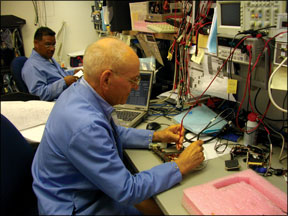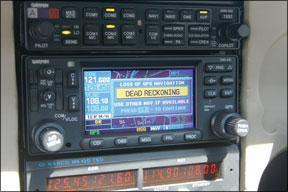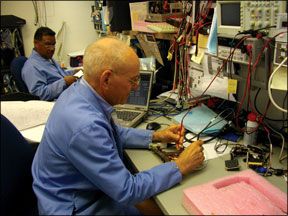Several of the major avionics manufacturers are offering extended warranty coverage for their high-end products. What may initially seem like a hard sell could ultimately save you a ton of dough. Its no secret that modern avionics are far from cheap, but out-of-warranty repairs and associated troubleshooting can be shockingly expensive. Even a basic factory repair on a modern navcomm radio can top $1000. Many consumers are skeptical of buying into warranty coverage. The sad fact is that extended warranties for radios, like nearly any other product, are a crap shoot. But before you tell Jos, “no way,” you need to consider the potential for savings plus the perceived value it might add to the aircraft if you try to sell it. 
Its the Hidden Costs
To make the correct decision in buying warranty coverage, you need to understand the potential costs for both minor and major repairs. For example, the display replacement for a Bendix/King KX155A navcomm radio will usually cost upwards of $500, even for a field repair. A meter failure in a KI209 navigational indicator essentially reduces the unit to throw-away status (this indicator is worth $2000 in factory-new condition). Repairs to an Avidyne EX5000 MFD thats out of warranty will yield a repair cost of $2250, and the turn-around time could be two weeks.
Freight costs are a large overhead in most avionics shops, and customers pay the freight for shipping boxes to and from the factory. Its a difficult problem for both aircraft owner and shop. The owner wants a rapid turn-around when ordering replacement components, but is often shocked at the freight charges that are passed along.
When it comes down to it, its not the responsibility of the shop to absorb overnight freight costs. Before you suggest overnight or other air freight options, ask the shop what the estimated costs of such will run so there are no surprises.
System troubleshooting, whether its on the test bench or in the aircraft, is pricey for several reasons. Shops need to maintain current calibration on nearly all equipment used for repair and diagnosis. Second, modern systems are rich with integration, which ups the troubleshoot time and effort. Its not always as easy as pulling a box for a quick bench-test and diagnosis. Many extended warranties pick up freight, diagnostic, and removal and reinstallation costs. This can be a huge savings on even the most basic repairs.
Garmin FliteLevel
Garmin only offers extended coverage for the components of the G1000 integrated avionics suite, and coverage for aftermarket retrofit products is not available. This warranty isn’t available for fractional or charter operations, aircraft outside of the United States or Canada, or for non-individual ownership such as flight training schools. It cant be added for aircraft that are out of their original warranty end date by more than one year. G1000 suites are initially covered for two years after delivery. FliteLevel extends coverage out for an additional three years (there is also a two-year option).
The Garmin extended warranty is transferable with the sale of the aircraft. Some owners told us that having the coverage in place helped close the deal when they went to the bargaining table.
FliteLevel covers nearly all components within the G1000 suite, called Line Replaceable Units or LRUs. These include remote transponders, audio systems, heading sensors and those big displays, to name a few. You can purchase coverage on equipment only, or equipment and labor. On average, the price Delta between covering the labor or not is $2000. We would opt to buy the labor coverage given the intense troubleshooting and disassembly effort thats often required in G1000 repair.
For G1000 full coverage in basic airplanes like a Diamond DA40, a full warranty package costs $5995 and includes the GFC700 autopilot system. In the more substantial Socata TBM850, a full package is $21,995. That includes coverage for the mighty GWX86 radar system.
Garmin has an extensive LRU exchange program in place, and our experience has proven that there’s always a generous supply of exchange units on hand. The coverage includes paid air freight outbound and call-tag service for return of the failed unit to the Garmin factory in Olathe, Kansas . you’ll need to have this warranty work accomplished at an authorized Garmin service center, of course, but youre bound to find one in nearly every region you fly. There’s even AOG emergency service available 24/7.
Whats not covered? The usual caveats of misuse, accidents, improper modifications, natural disasters and failures caused by other equipment that might be installed on the aircraft apply. Optional Garmin service bulletins for product improvement (of which there are plenty) arent included in the coverage, nor are regular maintenance-interval items, data and update cards, or data programmers.
Honeywell HAPP
Honeywell Avionics Protection Plan (HAPP) includes the Confidence Plan extended warranty for general aviation equipment. Commonly, this is the Silver Crown and Silver Crown Plus line of avionics. All contracts are based on complete coverage of all the avionics in the aircraft. If you have a newer Cessna with a complete stack of Silver Crown Plus gear, all of the units are included in the coverage. Picking and choosing specific boxes isn’t an option.

Dwelling on that Silver Crown Plus stack for a moment, consider that these radios certainly had their share of growing pains and as the fleet ages, repairs are becoming more common. In 2009 pricing, full-panel coverage including both navcomms GPS, transponder, audio panel, DME and ADF runs $1694 per a year. If an out-of-warranty navcomm were to smoke, you could pay more than this in repair or replacement. But then again, you might not have any failures at all. There’s the crap shoot.
Any unit thats offered in the Bendix/King factory-exchange pool is eligible for coverage. There are a variety of coverage options including year-by-year protection or an extension over several years. Unlike Garmin, Honeywell offers coverage for fleet operators. The Spares Exchange (SPEX) program provides LRU exchanges and rentals for warranty and non-warranty issues that are commonplace in the business aviation sector. SPEX is under the HAPP program for business jets. Honeywell pays shipping costs for air freight both ways on units requiring exchange, and also picks up the freight when a unit needs to go to the factory for repair. Customers work with authorized Honeywell Bendix/King dealers for warranty actions.
The shop is reimbursed through submitting a warranty claim for their effort in troubleshooting and the exchange. But one shop told us that there is a maximum to the hours that can be submitted, and often its not enough on aircraft that might require substantial teardown. While this might seem as if it doesnt affect the customer, thats not true. Some shops might refuse to work the exchange or repair if they feel they arent compensated fairly. We don’t think this happens often, and shops like that wont be in business for the long haul. But you still might run into that situation. Just take your repair job elsewhere.
The HAPP warranty can be transferred to a new owner so the contract has legs, adding to the value of the airplane. HAPP doesnt cover the usual consumables, including batteries, and it doesnt cover databases. The program does, however, cover no-charge loaners and AOG emergency service-an area thats more common than you might think. An owner of a Pilatus PC-12 told us the KMH880 combination traffic/terrain system in his airplane failed on the leg of a long trip, and a loaner was expedited overnight so he could continue on his way. Essentially, HAPP provides the same coverage one would expect on a system still under original factory warranty, except for the exclusions mentioned.
Avidyne FlexCare
FlexCare extended warranty from Avidyne offers the same benefits as the new-product warranty. It kicks in when the original warranty runs out. This is a multi-tier program that has many Avidyne owners confused. We agree that the warranty buy-in plan is overdone and somewhat complex.
With FlexCare, an Avidyne product can ultimately have a five-year warranty when you count the initial two-year warranty plus an additional three years of extended coverage. You have the option of purchasing one, two or three years of extended coverage. Bezel and glass restoration protection is included with an additional fee of $1100 if you use it. But if youre rough on your displays (weve seen pilots trash them in every way possible), it may be worth it.
Avidyne has warranty buy-in pricing structures for units that are in and out of warranty. For example, if you own an Avidyne product that still has remaining factory warranty, then the buy-in pricing to add additional coverage is less than if the unit was out of warranty. So the extended warranty begins when the original factory warranty ends.
There’s a slight dollar savings in buying the warranty before the original coverage ends, but not a whole lot. For example, buying three years of extended warranty coverage on an EX500 MFD thats past its original warranty would cost $1000. If you bought the same coverage but bought it while the original warranty was still in force, you would pay $750. For glass cockpits, a three-year warranty on a two-display Entegra system would cost $4200 out of warranty, and $3600 if its still under the original warranty. There is, however, one big caveat to this price difference, which we’ll hit in a minute.
All in-warranty repairs are part of Avidynes Platinum Exchange program, where theyll send you a replacement unit as soon as they receive your broken one. So the unit you get back and keep is not the same one you sent out.
If you need a replacement faster, your shop can supply a credit card, and Avidyne will ship a replacement product prior to receiving the failed unit, eliminating potential downtime. They call this Platinum Advanced Exchange.
Both inbound and outbound shipping is paid for by Avidyne, and there’s coverage for “reasonable” dealer removal and reinstallation, including set-up and calibration.
What kinds of problems might one expect from an otherwise reliable Avidyne product? Weve witnessed processor problems in the EX500/5000 where the unit would freeze on boot-up due to internal software or hardware corruption. This means a trip to the factory-and the flat rate repair cost- is a sure thing. There have also been control knob and display problems. Extended coverage is a blessing in these situations. The flat-rate repair pricing on an EX500 that is out of warranty is $1725. The EXP5000 PFD has a flat-rate repair of $2250.
Now for the caveats in this program. The only way for out-of-warranty customers to get FlexCare coverage is if they have a maintenance event and pay the retail flat-rate repair charge. So if you want to avoid ever paying for a flat-rate repair, you’ll need to sign on before your factory warranty runs out. FlexCare does not include hardware upgrades or any new features that come with software upgrades. Customers who purchase FlexCare when the product is only 90 days out of warranty must sit out a 30-day grace period (so if the unit fails in the 30 days, you pay full retail flat-rate repair fees).
Bezel and glass replacement are not covered by FlexCare (a trashed display or bezel control is considered abuse). Bezel and glass replacement is a flat $1100 charge. One other beef we have with FlexCare: On the off chance the factory cant find anything wrong with the product after evaluation, a recertification fee of $750 is still charged.
Hedging your bet
As one happy owner of a Bendix/King HAPP warranty plan for his single-engine Cessna put it, “I would rather write a $1700 check to cover the entire stack of radios rather than paying that kind of money for a single repair, because Ive been there.” He told us that his warranty has paid for itself, or come close, almost every year. But he wears out components quickly since he flies his airplane a couple of hundred hours a year.
We think the Bendix/King HAPP program is a worthwhile investment given the types of failures that are becoming common as the equipment ages. Were disappointed that Garmin doesnt offer extended warranty on the hugely popular GNS-series units since this fleet is aging and repairs are becoming more widespread. Call it a double disappointment because the G1000 warranty situations weve been involved in show Garmin service to be consistently top-notch. Avidynes program is complicated but offers lots of options and decent coverage at a decent price point if you understand all of the caveats.
Bottom line? We think setting aside funds for avionics warranties is a wise decision, unless you want to gamble with periodic failures. The disappointing truth is that new avionics don’t guarantee years of trouble-free service and they are expensive to repair. Even if you don’t use the coverage every year, you should still feel confident knowing its there because, eventually, you’ll probably need it.
Larry Anglisano is our avionics editor, a title that only exists because avionics have become so freakin complicated and expensive.





